
Final Fantasy Adventure, known in Japan as Seiken Densetsu: Final Fantasy Gaiden or simply Seiken Densetsu, and later released in Europe as Mystic Quest, is an action role-playing video game developed and published by Square for the Game Boy. It is a spin-off of the Final Fantasy series and the first game in the Mana series. It was re-released by Sunsoft in April 1998.
Dragon Quest, previously published as Dragon Warrior in North America until 2005, is a series of role-playing games created by Japanese game designers Armor Project, Bird Studio and Sugiyama Kobo to its publisher Enix, with all of the involved parties co-owning the copyright of the series since then. The games are published by Square Enix since its inception, with localized remakes and ports of later installments for the Nintendo DS, Nintendo 3DS, and Nintendo Switch being published by Nintendo outside of Japan. With its first game published in 1986, there are eleven main-series games, along with numerous spin-off games. In addition, there have been numerous manga, anime and novels published under the franchise, with nearly every game in the main series having a related adaptation.

Square Enix Holdings Co., Ltd. is a Japanese multinational holding company, video game publisher and entertainment conglomerate. It releases role-playing game franchises, such as Final Fantasy, Dragon Quest, and Kingdom Hearts, among numerous others. Outside of video game publishing and development, it is also in the business of merchandise, arcade facilities, and manga publication under its Gangan Comics brand.

The Mana series, known in Japan as Seiken Densetsu, is a high fantasy action role-playing game series created by Koichi Ishii, with development formerly from Square, and is currently owned by Square Enix. The series began in 1991 as Final Fantasy Adventure, a Game Boy handheld side story to Square's flagship franchise Final Fantasy. The Final Fantasy elements were subsequently dropped starting with the second installment, Secret of Mana, in order to become its own series. It has grown to include games of various genres within the fictional world of Mana, with recurring stories involving a world tree, its associated holy sword, and the fight against forces that would steal their power. Several character designs, creatures, and musical themes reappear frequently.

Secret of Mana, originally released in Japan as Seiken Densetsu 2, is a 1993 action role-playing game developed and published by Square for the Super Nintendo Entertainment System. It is the sequel to the 1991 game Seiken Densetsu, released in North America as Final Fantasy Adventure and in Europe as Mystic Quest, and it was the first Seiken Densetsu title to be marketed as part of the Mana series rather than the Final Fantasy series. Set in a high fantasy universe, the game follows three heroes as they attempt to prevent an empire from conquering the world with the power of an ancient flying fortress.

The Slime series is a spinoff series of games from Dragon Quest featuring its Slime character. Three games have been released, the second of which, Dragon Quest Heroes: Rocket Slime, has been released in North America.
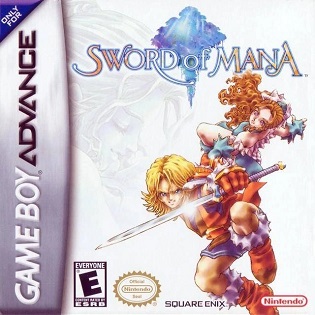
Sword of Mana, originally released in Japan as Shin'yaku: Seiken Densetsu, is a 2003 action role-playing game developed by Square Enix and Brownie Brown and published by Square Enix and Nintendo for the Game Boy Advance. It is an enhanced remake of the first game in the Mana series, the Game Boy game Seiken Densetsu: Final Fantasy Gaiden, which was released as Final Fantasy Adventure in North America and as Mystic Quest in Europe. Sword of Mana was the fifth release in the series. Set in a high fantasy universe, the game follows an unnamed hero and heroine as they seek to defeat the Dark Lord and defend the Mana Tree from enemies who wish to misuse its power.
Kenshin is a Japanese masculine given name. It may refer to:
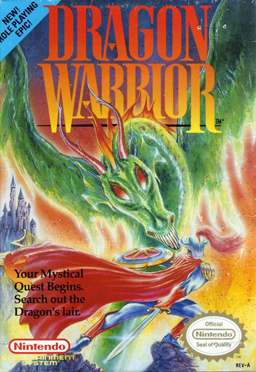
Dragon Quest, titled Dragon Warrior when initially localized to North America, is a role-playing video game developed by Chunsoft for the Nintendo Entertainment System. It was released by Enix in Japan in 1986 and by Nintendo in North America in 1989. It is the first game in the Dragon Quest video game series. Dragon Quest has been ported and remade for several video game platforms, including the MSX, MSX2, PC-9801, Super Famicom, Game Boy Color, Nintendo 3DS, PlayStation 4, mobile phones, and Nintendo Switch as of 2019. The player controls the hero character who is charged with saving the Kingdom of Alefgard and rescuing its princess from the evil Dragonlord. Dragon Warrior's story became the second part in a trilogy, with several spinoff anime and manga series.
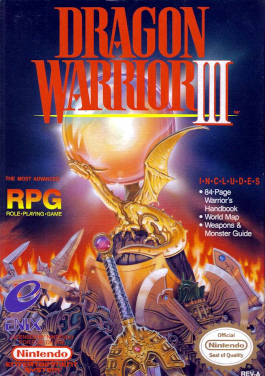
Dragon Quest III: The Seeds of Salvation, titled Dragon Warrior III when initially localized to North America, is a 1988 role-playing video game developed by Chunsoft and published by Enix. It is the third installment in the Dragon Quest series and was first released for the Family Computer (Famicom) in Japan and later for the Nintendo Entertainment System (NES) in North America. The game saw an enhanced remake for the Super Famicom in 1996 and the Game Boy Color in 2001, and a port to mobile phones and the Wii in 2009 and 2011. A version of the game for Android and iOS was released in Japan on September 25, 2014, and worldwide as Dragon Quest III: The Seeds of Salvation on December 4, 2014. It was the first time the game was given an official English subtitle. Later in 2021, another remake of the game titled Dragon Quest III HD-2D Remake, based on Octopath Traveler's style, was announced during the franchise's 35th anniversary livestream.

Dragon Quest VI: Realms of Revelation, known in Europe as Dragon Quest VI: Realms of Reverie, is a role-playing video game developed by Heartbeat and published by Enix for the Super Famicom as a part of the Dragon Quest series and as the last Dragon Quest game in the Zenithian Trilogy. It was released in Japan in December 1995, developed by Heartbeat; whereas the previous Dragon Quest games were developed by Chunsoft. In 2011, a remake of the game, along with Dragon Quest IV and Dragon Quest V, was released worldwide for the Nintendo DS, making this the first time the game was released in English. Another version of the game for Android and iOS devices was released in Japan in June 2015.

Legend of Mana is a 1999 action role-playing game developed and published by Square for the PlayStation. It is the fourth game in the Mana series, following 1995's Trials of Mana. Set in a high fantasy universe, the game follows an unnamed hero as they restore the land of Fa'Diel by creating the world around them and completing a number of interrelated quests in order to restore the Tree of Mana.
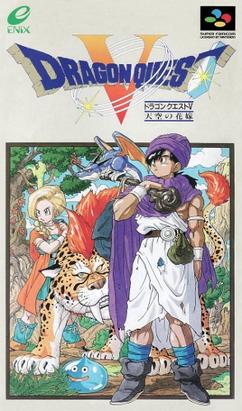
Dragon Quest V: Hand of the Heavenly Bride is a role-playing video game and the fifth installment in the Dragon Quest video game series, second of the Zenithian Trilogy. Originally developed by Chunsoft and published by Enix Corporation, Dragon Quest V was the first title in the series to be released for the Super Famicom video game console in Japan in September 1992. Dragon Quest V was the first game in the series to not be released in America due to programming issues at the time.
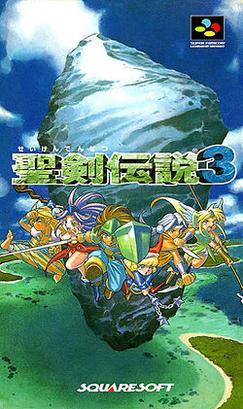
Trials of Mana, also known by its Japanese title Seiken Densetsu 3, is a 1995 action role-playing game developed and published by Square for the Super Famicom. It is the sequel to the 1993 game Secret of Mana, and is the third installment in the Mana series. Set in a high fantasy world, the game follows three heroes as they attempt to claim the legendary Mana Sword and prevent the Benevodons from being unleashed and destroying the world. It features three main plotlines and six different possible main characters, each with their own storylines, and allows two players to play simultaneously. Trials of Mana builds on the gameplay of its predecessor with multiple enhancements, including the use of a time progression system with transitions from day to night and weekday to weekday in game time, and a wide range of character classes to choose from, which provides each character with an exclusive set of skills and status progression.
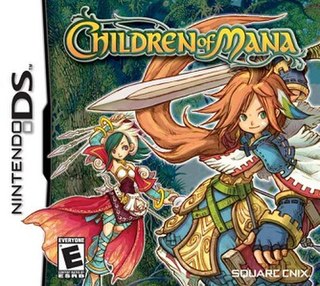
Children of Mana is a 2006 action role-playing game for the Nintendo DS handheld console. It was developed by Square Enix and Nex Entertainment, and published by Square Enix and Nintendo. It is the sixth game of the Mana series—following 2003's Sword of Mana—and the first entry in the World of Mana subseries. Set in a high fantasy universe, Children of Mana follows one of four young heroes as they combat an invasion of monsters and learn about the cataclysmic event that killed their families.

Tose Co., Ltd. is a Japanese video game development company based in Kyoto. It is mostly known for developing Nintendo's Game & Watch Gallery series, various Dragon Ball games, as well as other Nintendo products. Tose has developed or co-developed over 1,000 games since the company's inception in 1979, but is virtually never credited in the games themselves. Tose maintains a policy of having no creative input into the work they do, going so far as to refuse to put their names in the credits for most of the games they work on. As such, Tose has gained a reputation for being a "ghost developer".

Dragon Quest Swords: The Masked Queen and the Tower of Mirrors is a role-playing video game developed by Genius Sonority and 8ing and published by Square Enix for the Wii game console. The game is a spin-off from the Dragon Quest series, and was first released in Japan in July 2007, and worldwide the following year.
The Japan Game Awards is the Japanese Ministry of Economy, Trade and Industry's awards ceremony, which was created in 1996 as the CESA Awards. While it represents the Japanese video game industry, it is not limited to Japanese video games, but also includes international video games.

Slime Mori Mori Dragon Quest 3: Daikaizoku to Shippo Dan is a 2011 action-adventure game by Square Enix for the Nintendo 3DS. It is a spinoff video game to the Dragon Quest series, and the third entry in the Slime subseries. The game has not seen an official English release, but a fan-made translation patch has been made available.

















